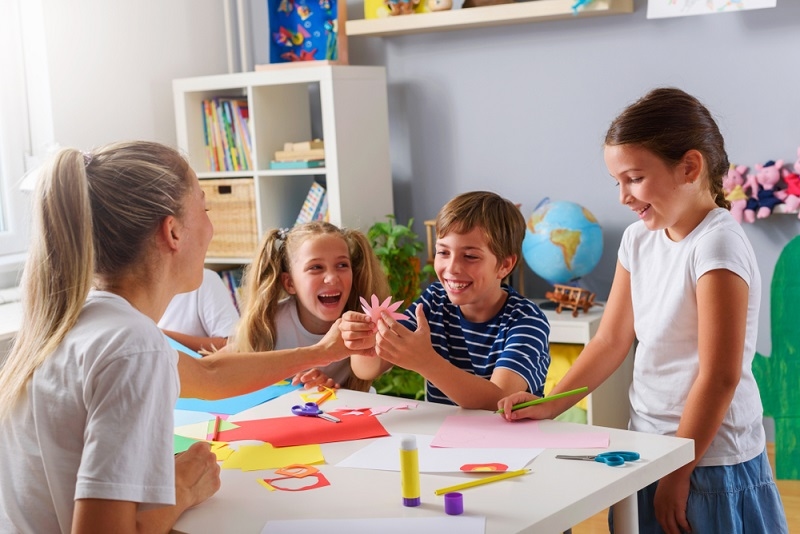
The academic scores often take the spotlight, but something similarly important in shaping young minds often gets overlooked. It is social and emotional learning.
This cannot be taught or trained because it requires in conversations among children to develop their skills to understand each other.
It even helps children to develop the inner tools to manage their emotions, build relationships, and take better decisions. These skills allow children to excel not just in their academic life but also in their professional career.
This blog will explore everything related to social and emotional learning and explain its importance.
Social and emotional learning or SEL is the process through which children and adults can learn and apply the skills to do the following things:
Rather than being a one-time lesson, SEL is woven into the way children interact at school, at home, and in their communities. It teaches them how to pause before reacting, how to read social cues, and how to express themselves in healthy, respectful ways.
Imagine a child learning to identify frustration instead of throwing a tantrum, or another finding the courage to apologize after an argument. These are quiet victories — but they build lifelong habits.
In many classrooms today, social and emotional learning in the classroom is no longer a side project. It's embedded in how teachers design their day — from morning check-ins to group discussions.
Here’s how educators are integrating SEL into everyday learning:
Starting the day by letting students express how they feel using colors, emojis, or journals.
Safe spaces where students share thoughts, listen actively, and practice empathy.
Activities that require communication, compromise, and teamwork.
Writing prompts that encourage self-awareness and goal setting.
Practicing peaceful problem-solving through scenarios or role-play.
These aren’t flashy methods. But they help shape students who don’t just memorize facts — they understand themselves and care for others. That’s a different kind of intelligence, and one that’s often underrated.
The benefits of SEL stretch far beyond childhood. When children are emotionally aware and socially skilled, every part of their life becomes more balanced — from academics to friendships.
When schools adopt SEL as a core approach rather than a side unit, the change in atmosphere is often noticeable. Students speak more politely and teachers report smoother transitions and fewer behavioral issues.
SEL makes everyone more connected and which makes the learning sustainable.
So, what do social and emotional learning activities actually look like? They don't always need to be elaborate. In fact, some of the most effective ones are grounded in simplicity and consistency.
Here are examples of SEL activities that teachers and parents can use:
Kids act out different emotions while others guess, helping build emotional vocabulary.
Encouraging children to write or draw three things they’re thankful for each day.
Practicing empathy by stepping into someone else’s shoes and reflecting on how they might feel.
Teaching deep breathing to calm the body and reset during stressful moments.
Setting small daily goals like giving a compliment or helping a friend.
These activities aren’t just fun — they’re also strategic. They create regular space for children to practice empathy, patience, and positive self-talk. Over time, that practice turns into instinct.
When people refer to social and emotional learning SEL, they are recognizing that this is a framework to develop a growth mindset that is emotionally healthy for their children.
It doesn’t just belong in schools or therapy rooms. SEL can — and should — be a shared responsibility. That means families, caregivers, educators, and communities all play a role in helping children develop emotional insight and social skills.
Here’s what that support can look like at a broader level:
The more consistent these messages are, the stronger and more natural these skills become. Children begin to understand that it’s okay to feel overwhelmed — what matters is how they handle it.
As powerful as SEL is, bringing it into every classroom or home doesn’t come without challenges. Educators often face limitations in time, training, and resources. In some environments, emotional education is not always prioritized.
Here are a few common roadblocks:
Despite these hurdles, small steps can still create impact. Even a five-minute daily routine or a weekly classroom discussion can open doors for emotional growth. And with proper support, more schools are finding ways to integrate SEL effectively and respectfully.
Today’s children are growing up in a world filled with fast-paced information, social pressures, and complex challenges. In such a setting, knowing how to solve a math problem is important — but knowing how to navigate peer pressure or bounce back from failure might matter even more.
Social and emotional learning equips kids not just to succeed, but to thrive. It helps them stay grounded when things feel overwhelming and teaches them to relate to others in a meaningful, respectful way.
With rising concerns about youth mental health and school safety, there’s never been a more urgent time to help children understand themselves and each other. SEL isn’t just a nice extra. It’s essential.
So why does social and emotional learning matter for kids? Because it builds the foundation they’ll carry for life.
It is in the quiet moments — the apology after a fight, the deep breath before speaking out, the support offered to a friend in need — where SEL lives. And those are the moments that shape the kind of people children become. In a world that often values performance over presence, SEL reminds people that being emotionally connected is just as important as being academically prepared.
This content was created by AI